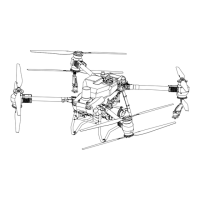AGRAS T50/T25
Unmanned Aircraft Flight Manual
52
©
2023 DJI All Rights Reserved.
If the RTK dongle is mounted to the remote controller for adding points, make sure
that RTK positioning is enabled. Go to
, tap RTK to select the RTK signal source,
and complete configuration. Wait until the system status bar on the upper left of the
screen turns green, indicating that RTK positioning is being used.
2. Mark obstacles and non-spraying areas.
a. Select Obstacle as the type of point, drag the map, and tap Add to add a point at the
crosshairs. The obstacle will then be marked.
b. Select Round as the type of point. A red circle will appear on the map. Tap the center of
the circle to select the obstacle and drag to adjust its position. Select the red point on the
edge of the circle and drag to adjust the radius.
c. Select Non-Spraying Area as the type of point, and then drag the map to add boundary
points around areas that do not need to be sprayed, such as clearings and ditches.
3. Set the route parameters.
The app produces a task route automatically after the field is applied. The green point on
the route indicates the start point while the yellow point indicates the end point. The route
settings are as follows.
a. Drag
near the route to adjust the flight direction of the planned route. Tap to show
the Fine Tuning menu and adjust the route manually. Tap one of the boundaries to select
it and then tap it twice to align the route direction with the selected boundary.
b. Route Spacing: Set the distance between two neighboring routes.
If Auto Route Spacing Adjustment is enabled in Advanced Settings under Aircraft
Settings, fine tuning is applied automatically after users adjust the value of the
spacing. This will make the route more suitable for the task area.
c. Widen Field Margins: Adjust the distance between the boundaries and the routes near the
field boundaries. Tap to select a boundary and adjust the distance between the routes
and the selected boundary.
d. Obstacle Boundary Safety Distance: Adjust the distance between the obstacle boundary
and the route to prevent the aircraft from getting too close to the obstacle.
e. Start Point: Tap Set to the right of Start Point, select a boundary point and tap Save. The
start point of the route will change to a location close to the selected boundary point.
f. Advanced Settings: Coverage Area, Course Angle, Route Segmentation and Low Speed
Ascent can be set in Advanced Settings.
Coverage Area: If Route & Boundary is selected, the aircraft will fly and spray around the
boundary of the field after reaching the endpoint.
Course Angle: When Auto Optimization is enabled, the app will automatically generate
the optimal flight route. Users can also adjust the course angle manually.
Route Segmentation: Tap Set to open Route Segmentation. Tap and drag the sliders at the
bottom to adjust the position of the start point (green) and end point (yellow) to segment
the route.
Low Speed Ascent: When enabled, the aircraft will ascend to the preset height with a low
speed to avoid damaging vegetation.
4. Tap
, name the field, and save. The newly added field will be displayed in the field list.

